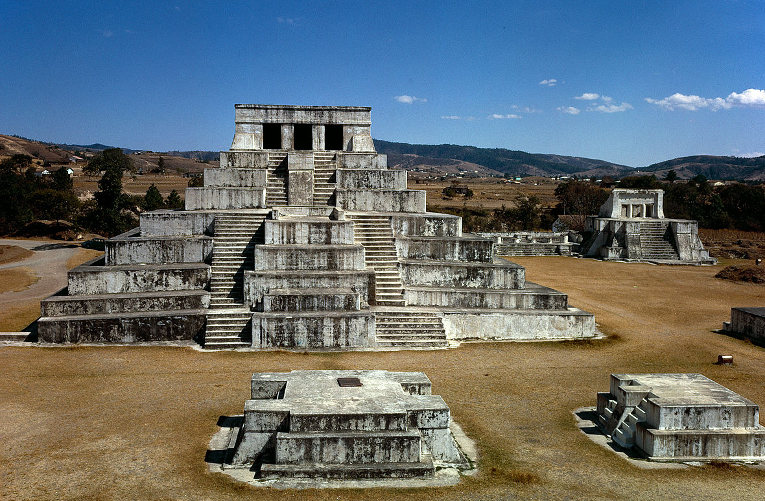A new study finds that it was a severe and long-lasting megadrought that destroyed the great Mayan civilization a thousand years ago.
But the research has ominous relevance for us today since America’s top scientists have warned us that President Trump’s climate policies will make such civilization destroying megadroughts commonplace in the coming decades.
The Mayans had one of the world’s first written languages, used advanced mathematics, measured time with an accurate calendar, produced durable rubber three millennia ago, and figured out “how to grow corn, beans, squash and cassava in sometimes-inhospitable places.”
Yet after reaching its height in its “Classic” period (250 AD – 800 AD), the Mayan empire collapsed over the next two hundred years. While many theories have been offered — including environmental degradation, war, and drought — researchers from Cambridge’s Godwin Laboratory for Palaeoclimate Research have shown that the collapse “correlated with an extended period of extreme drought.”
In a recent study published in the journal Science, “Quantification of drought during the collapse of the classic Maya civilization,” the researchers calculated for the first time just how bad the drought was.
From 800 to 1000 AD, they found, “Annual rainfall must have fallen by around 50% on average and by up to 70% during peak drought conditions.” In addition, “relative humidity dropped by 2% to 7%” compared to today.
“The role of climate change in the collapse of Classic Maya civilization is somewhat controversial, partly because previous records are limited to qualitative reconstructions, for example whether conditions were wetter or drier,” explained lead author Nick Evans.
“Our study represents a substantial advance as it provides statistically robust estimates of rainfall and humidity levels during the Maya downfall.”
This study is especially relevant today for two reasons. First, America has already started experiencing warming-worsened droughts that are as bad as any drought seen in the past 1200 years.
Second, climate scientists have shown that under current climate policies we face even worse multi-decade megadroughts.
For instance, here is a 2015 NASA projection of what the normal climate of North America will look like on our current emissions path. The darkest areas have soil moisture comparable to that seen during the 1930s Dust Bowl.
This is business-as-usual under Trump’s climate policies, which are aimed at undermining both domestic and global action on curbing the use of fossil fuels. We could see a severe megadrought lasting decades hitting both the California breadbasket and the Midwest breadbasket at the same time.
Also, tens of millions of people in Mexico and Central America — (Mexico alone is projected to have a population of 150 million in 2050) — will be desperately trying to find a place to live that isn’t so hot and dry, and that has enough fresh water and food to go around. They aren’t going to be looking south (and, of course, their coastal cities will be inundated by accelerating sea level rise).
A couple million Syrian refugees has turned global politics upside-down in recent years. What happens when that is multiplied 10-fold? Or 50-fold?
“Human adaptation to prolonged, extreme drought is difficult or impossible,” as ThinkProgress has pointed out in a 2011 review article in the journal Nature on prolonged drought driven by climate change. “Historically, the primary adaptation to dust-bowlification has been abandonment; the very word ‘desert’ comes from the Latin desertum for ‘an abandoned place’.”
Just last fall, the White House approved the definitive National Climate Assessment by America’s top scientists, which also projected that most of the country would see serious to devastating drops in soil moisture most of the year.
The following map shows the key projections for change in soil moisture by 2100 in the “higher emissions” (business as usual) case, the one the Trump administration’s policies would lead to.
PROJECTED CHANGES IN SOIL MOISTURE IN “HIGHER EMISSIONS” SCENARIO. DOTS INDICATE WHERE CHANGES WOULD BE LARGE COMPARED VARIATION. CREDIT: NCA.
This would be the “new normal” climate, a near permanent state of drought over large segments of our country, including much of the California and Great Plains breadbaskets. In such a world, the United States — and indeed, a great many countries — would routinely suffer megadroughts as intense as the 1930s Dust Bowl, but lasting many decades and much hotter.
To get to the more manageable “lower emissions” scenario, America and the world must far exceed the emissions reduction goals agreed to in Paris in December 2015.
Trump’s decision to withdraw the U.S. from the Paris accord, however, and kill actions aimed at meeting our commitment puts the world on track for a “higher emissions” scenario. This is expected to lead to impacts unimaginably worse than anything the Mayans had to deal with.







